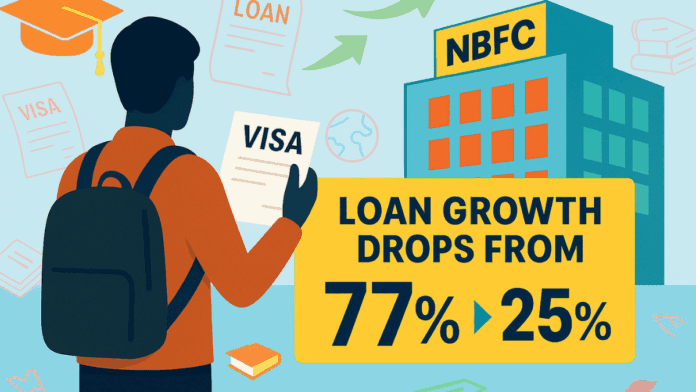India’s Non-Banking Financial Companies (NBFCs) are facing a sudden shift in their fast-growing education loan business. The reason? New and stricter student visa rules in the United States and Canada. These two countries have long been the top choices for Indian students looking to study abroad. But with visa approvals slowing down, NBFCs are now forced to change direction. They are quickly exploring new markets and education loan segments, both overseas and within India.
Sharp Drop in Education Loans Linked to US and Canada
Education loans had been booming for NBFCs in recent years. In FY2024, their education loan business grew by a massive 77%. But things took a turn in FY2025, with growth slowing to 48%. And now in FY2026, it’s expected to drop further to just 25%.
This slowdown is mainly because of fewer Indian students heading to the US and Canada. In the US, visa interview slots have been reduced, and some work-related benefits for students after graduation are under review. Because of this, loans given for studying in the US dropped by almost 30% last year.
Canada also made changes. Students now need to show more funds before getting a visa. The country has also set a limit on how many students can come in. These actions have made it tougher for students to plan higher education there, resulting in fewer loan applications.
???? UAE’s Golden Visa Shakeup Sparks Talent Drain from US and UK—Indian Migrants Rethink Future
Due to all these changes, overall education loan disbursements by NBFCs grew only around 8% in FY2025, compared to nearly 50% the year before.
NBFCs Shift Focus to New Countries and Domestic Education
To cope with this sharp drop in demand for US and Canada-bound education loans, NBFCs are now shifting gears. They are turning to other countries such as the UK, Germany, Ireland, and some smaller European nations. Loans for these destinations doubled over the last year.
As a result, the share of these countries in the total international education loan market grew from 25% in FY2024 to nearly 50% in FY2025. However, this growth is not enough to make up for the large decline in loans linked to the US and Canada.
The share of loans to the US dropped from 53% in March 2024 to 50% in March 2025 and is expected to fall further.
At the same time, NBFCs are exploring more domestic education opportunities. This includes funding for schools, coaching classes, online certifications, and skill development programs. These loans are usually of smaller amounts but help NBFCs spread their reach and reduce reliance on just foreign-bound students.
Golden visa hype crashes into legal wall—no law, no applications, no future
Asset Quality Still Strong, But Caution Ahead
Even with the major changes happening in the education loan market, NBFCs have managed to keep their loan performance strong. As of March 2025, only 0.1% of their education loan portfolio turned into bad loans or NPAs (non-performing assets).
Even if we count loans that are still under a moratorium (where students are not required to make payments yet), the NPAs remain low—around 0.7%. This means students have mostly been responsible with repayments so far.
However, there is a reason to stay alert. About 85% of the education loans are still under moratorium. In this fiscal year, nearly 15% of these loans will come out of this period. That means many students will soon start making repayments. If some of them struggle to pay back, the overall asset quality could come under pressure.
NBFCs are also entering newer areas like domestic education and different foreign markets. These are untested waters for many lenders. It remains to be seen how students in these new areas handle their repayments.
Despite the slowdown in growth, the education loan portfolio is still expanding in size. From ₹43,000 crore in FY2024, it rose to ₹64,000 crore in FY2025, and is expected to reach ₹80,000 crore by FY2026. Still, the pace of growth is clearly cooling down.
